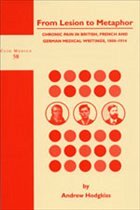Most non-malignant chronic pain is medically unexplained. But that has not stopped doctors from trying. These improvisations at the limit of medical knowledge offer a way into the history of neurosis.
Lesionless pain was a paradigmatic problem of clinical method after 1800. It was central to the emergence of neuralgia, spinal irritation, surgical hysteria, railway spine and hysterical conversion. Evidence of a nineteenth-century tradition of theoretical discussion about the relationship between chronic pain and pathological lesion, trauma, mood, memory and personality is brought together here for the first time. A wide range of medical texts is surveyed, including pathology, surgery, physiology, neurology, psychiatry and psychoanalysis. We see the medical gaze first penetrate the tissues of the body then extend to examine the language and mental state of the pain patient.
This history of chronic pain should be of interest to medical historians, pain clinicians, liaison psychiatrists, clinical psychologists and psychotherapists.
Table of contents:
Abstract. Acknowledgements. Introduction. Secondary Literature Review and Methodological Remarks. Chapter One: The Birth of a Problem. Chapter Two: A Local Irritation. Pain without lesion in the writings of French and British physicians and surgeons: 1820-40. Chapter Three: Gemeingefühl. German Romanticism, cenesthesis and subjective pain: 1794-1846. Chapter Four: Reflexion and Depression. Pain without lesion in mid-century German and British 'neurological' and 'psychiatric' writings: 1840-55. Chapter 5: Functional Nervous Disorders in French and British Medical Texts: 1859-71. Chapter 6: Functional Nervous Disorders in French and British Medical Texts: 1866-1886. Chapter 7: Psychalgia and Conversion. Pain without lesion in late nineteenth-century psychiatric and psychoanalytic writings: 1872-95. Chapter 8: Pain ans Psychopathology in Early Twentieth-Century French and German Psychiatric Writings: 1900-14. Conclusions. Bibliography. Index.
Lesionless pain was a paradigmatic problem of clinical method after 1800. It was central to the emergence of neuralgia, spinal irritation, surgical hysteria, railway spine and hysterical conversion. Evidence of a nineteenth-century tradition of theoretical discussion about the relationship between chronic pain and pathological lesion, trauma, mood, memory and personality is brought together here for the first time. A wide range of medical texts is surveyed, including pathology, surgery, physiology, neurology, psychiatry and psychoanalysis. We see the medical gaze first penetrate the tissues of the body then extend to examine the language and mental state of the pain patient.
This history of chronic pain should be of interest to medical historians, pain clinicians, liaison psychiatrists, clinical psychologists and psychotherapists.
Table of contents:
Abstract. Acknowledgements. Introduction. Secondary Literature Review and Methodological Remarks. Chapter One: The Birth of a Problem. Chapter Two: A Local Irritation. Pain without lesion in the writings of French and British physicians and surgeons: 1820-40. Chapter Three: Gemeingefühl. German Romanticism, cenesthesis and subjective pain: 1794-1846. Chapter Four: Reflexion and Depression. Pain without lesion in mid-century German and British 'neurological' and 'psychiatric' writings: 1840-55. Chapter 5: Functional Nervous Disorders in French and British Medical Texts: 1859-71. Chapter 6: Functional Nervous Disorders in French and British Medical Texts: 1866-1886. Chapter 7: Psychalgia and Conversion. Pain without lesion in late nineteenth-century psychiatric and psychoanalytic writings: 1872-95. Chapter 8: Pain ans Psychopathology in Early Twentieth-Century French and German Psychiatric Writings: 1900-14. Conclusions. Bibliography. Index.

